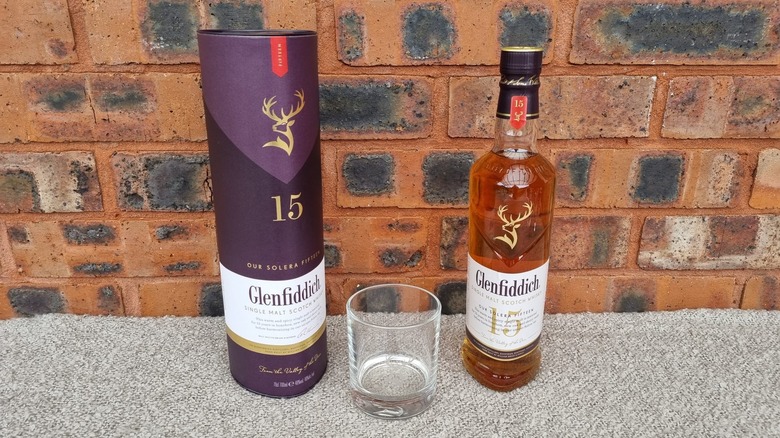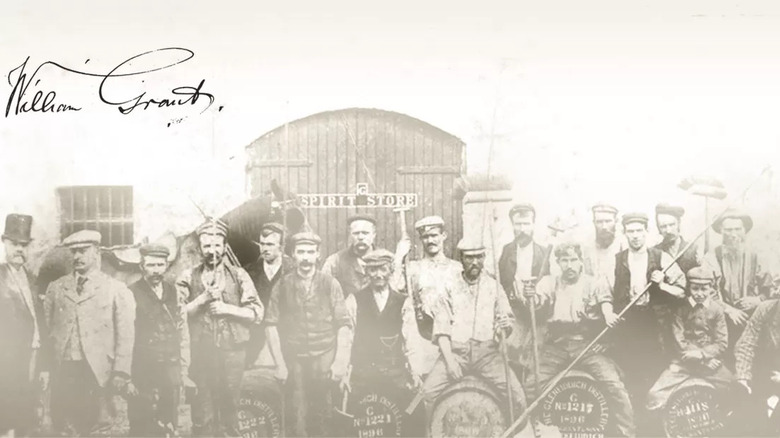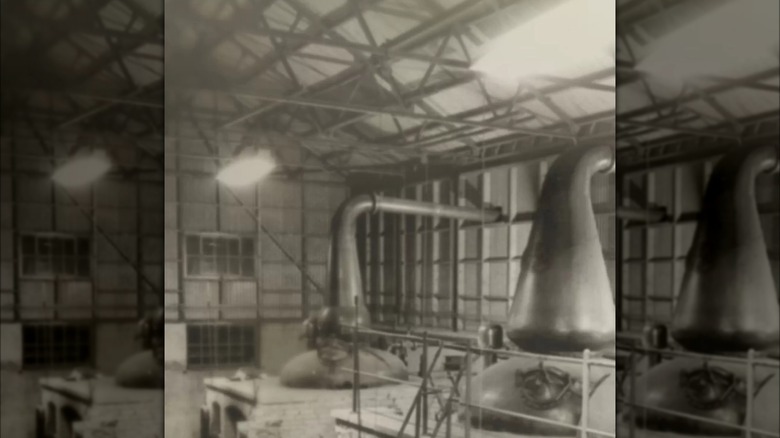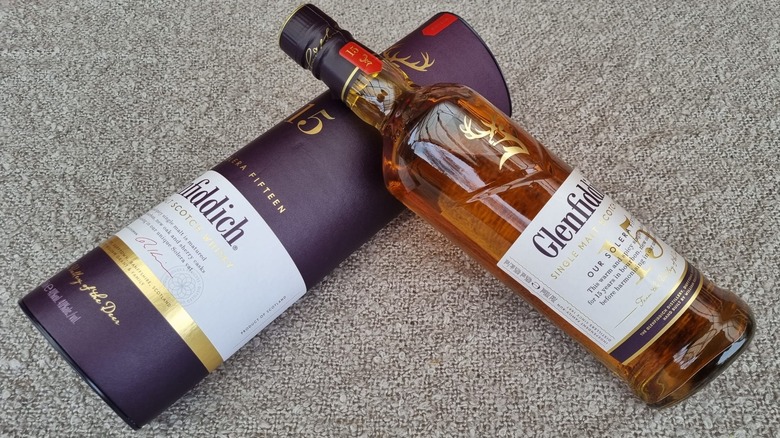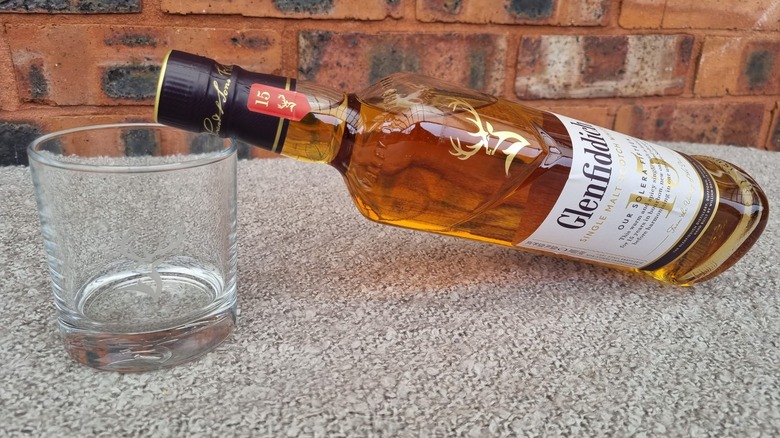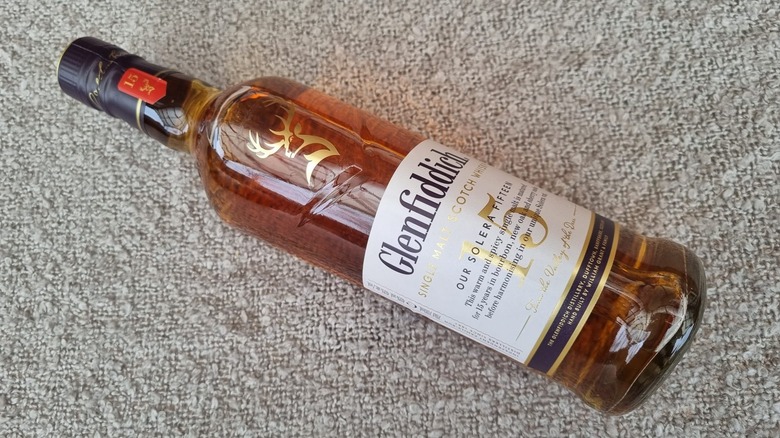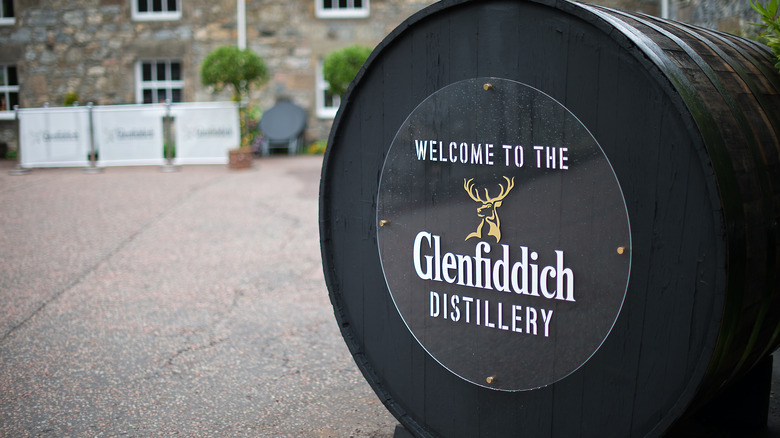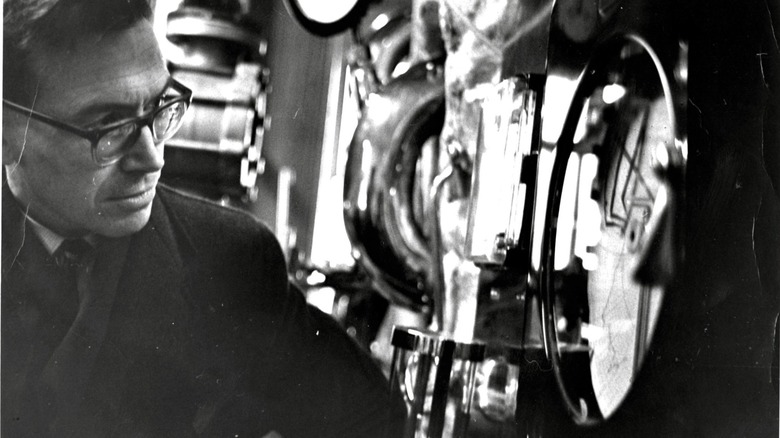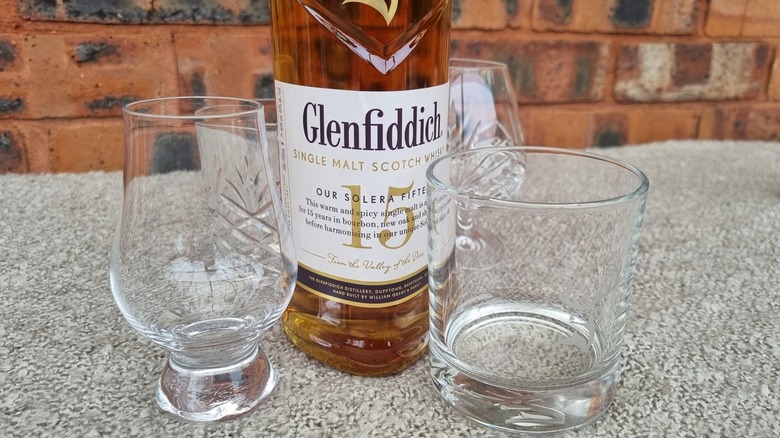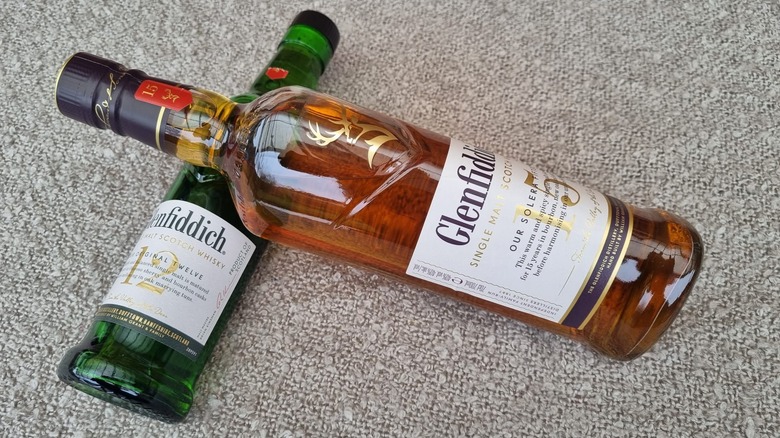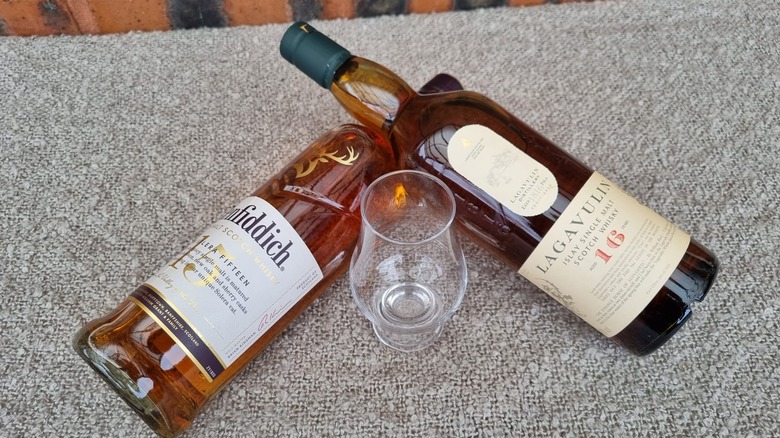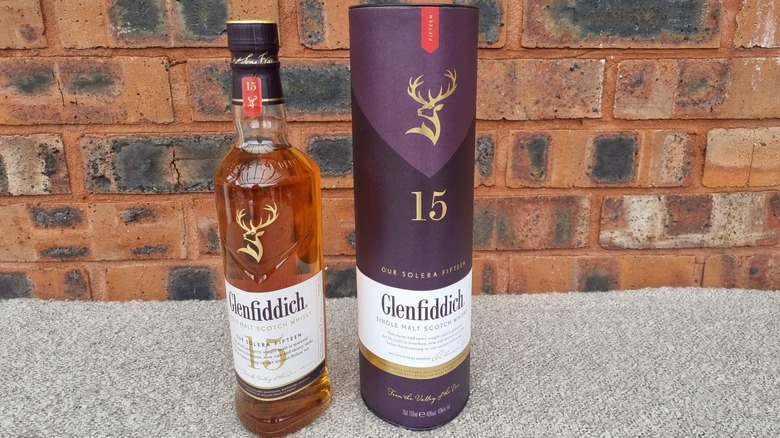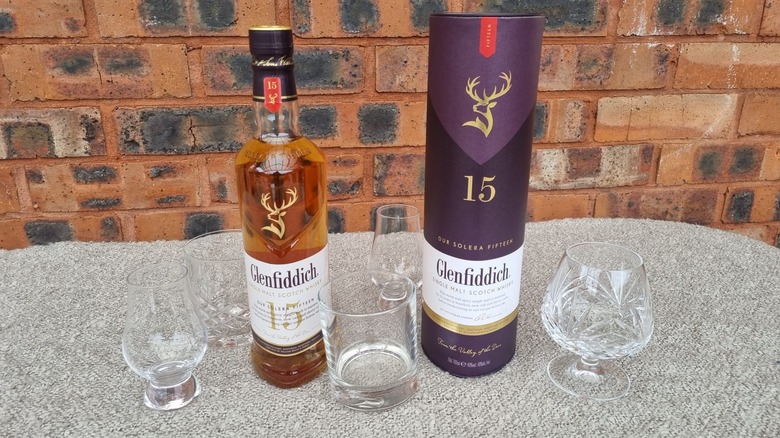Glenfiddich 15: The Ultimate Bottle Guide
Crafted by the famous Glenfiddich Distillery, this 15-year-old expression is a fantastic option for anyone looking for a reasonably priced maturely aged Scottish single malt whisky of exquisite quality. Established in 1886, the distillery remains family-owned and, throughout its existence, has upheld a commitment to quality and excellence. The Glenfiddich 15-year forms a part of its core line up, and every whisky lover should enjoy this bottle at some point. We were lucky enough to receive a bottle from the company but have also had the pleasure of sampling it before.
Armed with that knowledge, you'll soon know everything there is to know about the Glenfiddich 15-year. With a smooth yet deep profile, this expression boasts many flavors, including oak, toffee, and a range of spices. Its smoothness makes it a great choice for a whisky novice, but it has the depth to satisfy any enthusiast. However, our journey into the world of Glenfiddich will extend well beyond its tasting notes. We'll also delve into the brand's history, how it's made, and how this expression stacks up against some of its rivals. We'll unravel the story behind each sip and uncover the secrets that make Glenfiddich 15-year the number-one choice for many whisky drinkers.
Some recommendations are based on first-hand impressions of promotional materials and products provided by the manufacturer/distributor/etc.
Founded by the legendary William Grant
Glenfiddich owes its inception to the visionary William Grant. In 1886, he embarked on a journey to create a distillery and a company that would stand the test of time. He laid the foundations for a legacy that would endure for generations, and it all started with his huge family. Glenfiddich's family-orientated ethos was there from the very beginning. Grant, along with his nine children, constructed the distillery with their own hands. Through his company, William Grant & Sons, further distilleries were built, including Balvenie in 1892.
As the years unfolded, the legacy of William Grant has grown even stronger. Along with the whisky brands mentioned, William Grant & Sons owns Aerstone, Monkey Shoulder, Grant's, Clan McGregor, Drambuie, and Tullamore D.E.W., among others. It also owns many other spirit brands which showcases its huge influence. William Grant died in 1923, but his enduring spirit lives on. The company remains in family hands, with the current chairman being Glenn Gordon, a fifth-generation family member.
The History of Glenfiddich 15-year
After starting the work to build the distillery in 1886, Glenfiddich made its first drop of whisky in 1887 on Christmas Day. And, in 1903, the family-owned business was incorporated into William Grant & Sons and remains so to this day. After surviving the World Wars and prohibition, Glenfiddich remained strong and, in the 1950s, expanded its operation to include coppersmiths and a cooperage. This is one of many ways the popular Scotch brand has constantly pushed the whisky industry forward.
It has always fought bravely through challenges, and where some distilleries shut down operations in the '60s with a decline in the popularity of whisky, Glenfiddich expanded. In that decade, it would go on to market single malt whiskies and open up the first-ever dedicated visitor center. Its aggressive strategies have paid off throughout its history, making it the world's best-selling single malt and a global icon.
Glenfiddich has its own cooperage and coppersmith
What does that mean to say Glenfiddich has its own cooperage and coppersmith? A cooperage is where casks are built and repaired. This allows Glenfiddich to have more control over how its whisky is matured and allows experimentation with different maturation techniques. These days, the distillery doesn't make all of its barrels for two main reasons. The first is that it would be too big an operation, and the second is that new oak barrels are seldom used for whisky. Instead, Glenfiddich will outsource the operation to the likes of the Kelvin Cooperage in Kentucky. This cooperage creates casks for bourbon before they are returned, checked, and sent to Glenfiddich.
Added to the array of craftsmanship on-site in Glenfiddich are the coppersmiths. These are people responsible for building, maintaining, and caring for the distillery's many copper pot stills. It was in 1957 that this decision was made, and since then, the coppersmiths have been very busy. The distillery now boasts 42 stills, including 14 wash stills and 28 spirit stills. That adds up to a combined capacity of 13,500 liters, which is needed to meet Glenfiddich's demand.
A pioneer of whisky marketing
Glenfiddich not only stands as a pioneer in crafting exceptional single malt but has also played a hugely important role in revolutionizing whisky marketing. One part of its iconic branding is the distinctive logo. The proud stag simply comes from the Glenfiddich name, which means "valley of the deer" in Gaelic, with the English translation emblazoned on its bottles just below the neck. But, perhaps an even more iconic part of this brand is its triangular bottle. It makes them instantly recognizable on any bar shelf and helps to enhance the aesthetic appeal. To create this design, Glenfiddich sought the services of legendary graphic designer Hans Schleger.
Schleger was the man responsible for the London Underground's famous roundel sign, along with posters for the Second World War. Before working with Grant's, he'd worked with famous companies such as Shell, Martini, and John Lewis. The blended whisky was the first to receive the triangular bottle before its sister brand, Glenfiddich, adopted it. It wanted to associate its single malt with, which was then, a bigger brand in the form of Grants. Glenfiddich's marketing acumen extended to its use of tube packaging to sell the bottle, which helped give it the look of prestige and luxury. Glenfiddich's foresight in marketing strategies, from logo design to packaging, has shaped its identity and influenced the broader landscape of how whiskies are presented and marketed.
It expanded through prohibition
Prohibition decimated the American whiskey industry, with only a few distilleries being able to stay open. While its effects were, of course, most heavily felt in the U.S., it also significantly impacted the Scottish whisky industry, which was exporting huge quantities of spirits. Consumption was reduced, and the industry was facing unprecedented challenges. In the face of these problems, Glenfiddich went on the front foot. The distillery not only weathered the storm but emerged stronger. Showing resilience and strategic foresight didn't reduce production but increased it.
Glenfiddich fortified its position as a forward-thinking and risk-taking distillery. Due to this approach, it was able to remain a consistent presence in the market. Once prohibition was repealed in 1933, it had a distinct advantage over many rivals that had scaled back or ceased operations. Post-prohibition, Glenfiddich experienced a surge in popularity that the distillery has been riding ever since. America had an appetite for high-quality Scotch that Glenfiddich was more than happy to accommodate.
Its trucks run on whisky waste
Throughout the years Glenfiddich has shown its commitment to forward thinking and moving with the times. And, in the last few years, it has moved toward more sustainable practices, namely with how it transports its spirit to the various sites it owns. It has converted some of its whisky waste into a renewable resource by converting residues from the distillation process into Ultra-Low Carbon Fuel (ULCF). This produces very few emissions, especially compared with regular fuel.
Glenfiddich has become the first distillery to process 100% of its waste residues on-site and turn it into biofuel. It's a move that hopefully inspires other distilleries to explore innovative ways to reduce their environmental impact. The difference in pollution is huge as each truck will reduce annual carbon dioxide emissions by 250 tonnes, comparable to planting 4,000 trees. It's a small but significant step to a greener future for the whisky industry. Glenfiddich hopes to expand its biofuel operation across its entire fleet, further reducing its carbon footprint.
How is Glenfiddich 15-year made?
It would be easy to assume that all whisky is made the same way in an industry rich in tradition. While the basics of fermentation and distillation are the same, there are some significant differences. One of those differences is the water source, and for Glenfiddich, that is the Robbie Dhu Spring. Once the mash is created and yeast added for fermentation, it's time to distill the mixture. For Glenfiddich, this is done in one of 28 identical copper stills, which ensures consistency. Due to the commitment to these unique stills, the distillery still employs a coppersmith to maintain them.
Once the distillation process is complete, the spirit is ready for maturation. However, only the heart of the distillate is taken as the beginning and end of the run aren't as high quality. If the distillate isn't of sufficient quality, it is then distilled again. The 15-year is then aged in European oak sherry and new oak casks and matured in its large Solera vat. This type of oak tun is more commonly used for sherry and makes the spirit mellower. Glenfiddich's vat has been at least half full since 1998 to ensure consistency and depth. The process doesn't end there, as the 15-year is finally sent to oak marrying tuns to further ensure consistency before it's ready for bottling.
The first actively promoted single malt
The history of single malts is extremely difficult to determine. Throughout the history of Scotch whisky, there have been expressions that are technically single malts (whisky made with a single malted grain) but are not advertised as such. There have been others that were known as single malts but weren't widely known or marketed. They were also inconsistent, which is why there was a preference for blended whisky that could be mixed until they were more palatable. That changed with the introduction of the Glenfiddich Single Malt. This was an 8-year whisky that was marketed outside of the U.K. with a focus on American and Canadian markets.
The idea of a maturely aged single malt caught on and changed the face of the industry forever. This marked a paradigm shift, as distilleries realized there was a market for high-quality single malts along with more budget blends. If you look at a liquor shelf of scotch now, almost everything on the top will be a single malt with an age statement. It's easy to think that has always been the way, but the revolution only came into full force in the late 20th century, and it all started with Glenfiddich. The man responsible for the revolution was Sandy Grant Gordon, who was recognized for this legacy with a Lifetime Achievement Award from the International Wine & Spirit Competition in 2000.
What Does Glenfiddich 15-year taste like?
All of Glenfiddich's history and tradition counts for very little if the whisky doesn't taste great. Thankfully, it's something Glenfiddich has perfected. This scotch offers a sensory journey with its distinctive flavor profile that starts with its aroma and continues to finish. On the nose, you get an intriguing array of fruits. There are orchard fruits present, such as apples and pears, but they have a dark side to them. They are complemented by a prominent vanilla influence with a fresh and clean aroma. Floral undertones and a hint of honey complete the smell with a tantalizing glimpse of what's to come.
The first thing you'll notice about the palate is its smoothness. 80-proof alcohol shouldn't be this easy to drink, but it has an impressive subtlety that immediately lets you pick out its range of flavors. We detected strong hints of toffee with a range of spices. The most dominant was ginger but with a little sprinkle of cinnamon. Other influences, such as raisins and oaks, confirmed it as a whisky with an admirable level of complexity. You can pick out and experience a different tasting note with each sip, which is one of the true joys of sampling a fine scotch. The finish lingers as you'd expect, with the spice being notable on the tip of your tongue. Overall, the Glenfiddich 15 is characterized by being both impressively smooth and expressing an inviting array of flavors.
Glenfiddich 15-year vs. Glenfiddich 12-year
Glenfiddich's 12-year and 15-year expressions both stand as exemplary whiskies within the core lineup. Each offers a unique journey through the brand's rich heritage, but which is better? When compared to the 15-year, there is no doubt that the 12-year doesn't quite have the same level of depth. Two words that can be used for the 12-year are clean and fresh. It's an extremely approachable whisky that surely anyone would love. It doesn't overwhelm you on the nose, and there is nothing to dislike on the palate. You can immediately tell it has been maturely aged, as it has none of the harshness you'd expect with younger scotches.
While the 12-year-old deserves plenty of praise, the additional years of maturation and use of the solera vat give the 15-year-old a more refined and sophisticated drinking experience. While the Glenfiddich 12-year excels in its approachability, the Glenfiddich 15-year elevates the tasting journey, offering a nuanced and mature expression. Both have distinct characteristics, but as you may expect, the 12-year is usually comfortably cheaper. Due to this, we'd be happy to recommend the 12-year to anyone new to single malts. For those looking to drink something with a bit more complexity, the 15-year is a wonderful step up in quality.
Glenfiddich 15-year vs. Lagavulin 16-year
We thought comparing these two expressions would be a great idea for a few reasons. The first one is that they are similar in age. However, another reason was that they are two distinct styles of Scotch whisky with unique characteristics. The final reason is that we ranked the Lagavulin 16 as number one in our list of popular Scotch whiskies. The Glenfiddich 15-year didn't make that list, but how does it compare? Its fruity and floral notes make the Glenfiddich 15-year is all about elegance. There's only a touch of spice, and this mellow nature makes it extremely attractive for any whisky drinker.
In contrast, many see the Lagavulin 16-year as the king of robust and peaty malts. Hailing from the infamous island of Islay, it's unapologetically bold. The smoky aroma and intense flavors of seaweed and peat dominate the tasting notes. The maturation of both whiskies gives them depth and complexity but in completely different ways. Due to this, the choice between the two comes down to a matter of both preference and mood. On days when you want something bold and distinctive, you can't go wrong with Lagavulin 16. For those in a mellow mood searching for the subtle charms of a finely made Speyside dram, Glenfiddich 15 will never disappoint.
Is Glenfiddich 15-year expensive?
Glenfiddich 15-year is not a cheap Scotch. While that's true, it's not out of reach for most whisky enthusiasts, with an average price of around $80. Some stores often have it for around 15 to 20 dollars cheaper, and it's always a great idea to pick up a bottle when it's on offer. That price tag makes it an attractive option for anyone seeking a mature and well-crafted whisky that isn't going to break the bank. It balances quality and accessibility, making it a highly attractive option for anyone looking for a mature single malt.
As with any product, the question comes of whether it's good value for money. With the Glenfiddich 15-year, we'd have to say it does. It's almost impossible to find a Scotch whisky that has been matured for as long as this, tastes better, and is cheaper. This affordability has contributed to its popularity. That's because it appeals to novices looking for a higher quality whisky experience and seasoned connoisseurs looking to treat themselves with great scotch. If the Glenfiddich 15-year is a little too expensive for you right now, there are many cheaper single malts out there, but they won't be maturely aged as this.
How to drink Glenfiddich 15-year
How to drink whisky, especially single malt whisky, is always a hot topic. Many would say that such a maturely aged scotch should be enjoyed neat. Even adding ice is scowled at by some, as it can dilute the drink. In reality, you should enjoy any drink the way you want. That being said, Glenfiddich's 15-year spirit has been made with a dedication to quality and craftsmanship. Considering that, it's best to drink it neat for a few glasses to truly appreciate its character. You can then make a judgment call on how to finish your bottle.
Glenfiddich 15-year is known for its smooth profile, and at 80 proof, the alcohol content isn't going to overwhelm you. As with any new spirit, having your first taste in a high-quality glass is a great idea. The established choice is a tulip-shaped glass called a Glencairn glass. These glasses concentrate the aromas and allow you to open up the whisky and appreciate its viscosity and color. We wouldn't recommend adding it to mixers or cocktails, but you shouldn't feel guilty about doing so. With it not being a premium-priced spirit, Glenfiddich 15-year offers a broad spectrum of possibilities for every whisky enthusiast.
Methodology
All of the honest and independent opinions in this guide come from personal tasting experiences. All the whiskies mentioned in the article, including the Glenfiddich 15-year that was sent to us, have been sampled.
Along with this, I used a wide range of research materials to delve deep into the history of this brand. This combination aims to give you a trustworthy and comprehensive bottle guide.
